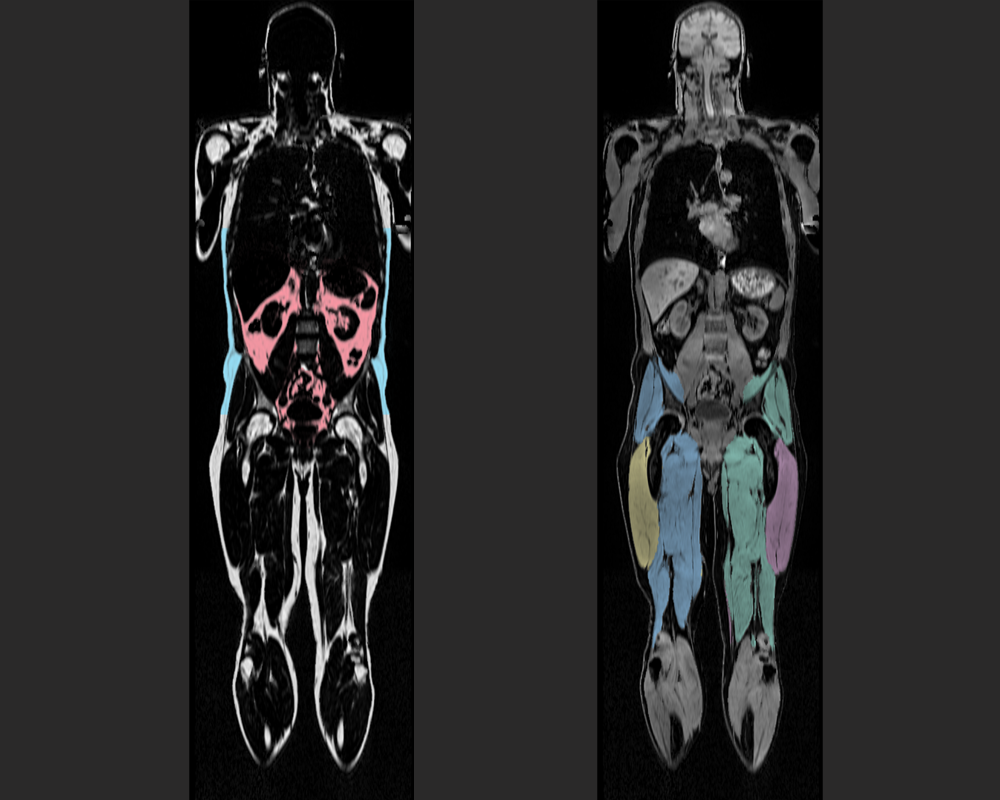磁共振成像 (MRI) 是一种医学成像技术,它在不使用电离辐射的情况下,利用强磁场、无线电波和计算机技术来生成人体器官和组织的详细图像。人类长寿科技公司基于自有的磁共振序列和软件技术,不需要注入造影剂就能生成高清晰度的图像,有助于癌症、心血管疾病、代谢性疾病和神经退行性疾病的早期检测。
MRI与CTPET检查的比较
电子计算机断层扫描 (CT) 通过从不同角度获取多张X射线图像,以重建三维(3D)图像。由于使用X射线,患者会暴露在电离辐射下,从而增加DNA损伤和后续患癌的风险。
正电子发射断层扫描(PET)是基于人体代谢活动进行成像的。PET扫描会使用放射性葡萄糖注射剂,这种物质在体内释放伽马射线形式的能量。由于癌细胞生长迅速,通常会摄取比正常细胞更多的葡萄糖,这些葡萄糖随后会被“困住”,并通过PET扫描被可视化。
PET和CT都会使个体暴露于较高剂量的电离辐射中,而磁共振成像(MRI)则使用非电离辐射——通过强磁场和射频能量生成三维图像。与CT相比,MRI在软组织对比度方面具有明显优势,能够提供有关体内组织和器官的极其详细的信息,而且目前尚无已知的不良副作用。
此外,通过先进的全身MRI技术,我们还能量化许多关键的健康参数,例如肝脏脂肪含量、内脏脂肪(围绕内脏器官的脂肪)、肌肉质量、大脑体积、射血分数(每次心脏收缩泵出的血液比例)等,还能筛查出如动脉瘤和癌症等重大健康问题。
HLI全身磁共振扫描
全身影像检查是HLI为所有客户提供的重要健康评估内容,无论他们是否存在疾病症状。这项三维成像检查能够评估身体结构和功能,有助于在疾病的最早阶段实现发现和干预,是主动健康管理的重要组成部分。
1备注: HLI使用的是全身和脑部的MRI检查,并仅在冠状动脉钙化评分中使用有限的CT扫描(扫描范围和曝光时间仅限于心脏)。
您的舒适是我们最关心的事项。以下是您在 HLI接受全身MRI扫描时可以预期的流程:
MRI 检查是一种多感官的体验,整个过程大约持续 60 至 90 分钟。您将平躺在检查床上,头部和身体周围会放置一系列线圈(即“摄像头”)以完成扫描。
在检查过程中,我们会为您提供耳塞或耳机,您可以选择喜欢的音乐,同时还有一系列舒缓的视觉画面供您观看,帮助放松身心。扫描时会发出不同频率和持续时间的声音,同时检查床也会有正常的移动。
部分客户可能会感受到轻微的体温升高或周边神经的刺激感,这些都是全身 MRI 检查中常见的正常生理反应。整个过程中,技术员将始终与您保持联系,确保您的舒适与安全。
* 如果您有幽闭恐惧症,我们建议您口服镇静药物以缓解不适。在服用镇静剂后的至少六小时内,我们不建议您自行驾车。根据您的需求,我们也可以协助安排交通接送服务,确保您的安全与便利。
HLI的MRI 扫描
您将在检查后一周内(或更早)收到影像报告及血液生化检测结果。如发现重大异常,您的长寿医生将与放射科医生合作,协助您进行下一步安排,包括进一步影像检查或转诊专科医生。
作为 100+ 会员,您每年将接受一次全身MRI扫描,以在疾病最早期阶段实现发现和干预。如有临床指征,也可能安排更频繁的检查(例如用于追踪MRI结果中的肝脏脂肪或内脏脂肪百分比变化)。
脑部MRI包括高分辨率的三维解剖图像,并通过机器学习技术实现图像的自动分割与定量分析。这种脑部分割的优势在于,能够为临床团队提供客观的数据支持,包括自动计算的体积指标和颜色编码的大脑结构图像,用于评估和追踪神经退行性脑部疾病的生物标志物。相关动态影像展示了从前向后的大约75%冠状切片,其余部分为保护隐私已去除。
无对比剂脑血管造影用于检查脑部血管,并能够检测到直径仅为3毫米的小型脑动脉瘤。动态影像展示了健康的血管系统,包括颈内动脉(通常用于测量颈动脉脉搏)和脑动脉,并通过顺时针旋转展现360度全景视角。位于影像中央、向左右延伸的中脑动脉是大面积中风时最常发生闭塞的主要动脉。
心脏MRI通过多角度影像检查心脏功能、组织特征和心脏瓣膜情况。动态影像展示了四腔心(左右心室和心房)的跳动视角。左心室每次收缩时排出的血液比例被称为射血分数(EF)。例如,60%的射血分数表示每次左心室收缩时排出60%的血液。HLI的心脏病专家将评估射血分数以及其他关键心脏生物标志物,并提供详细报告。
特定的全身MRI序列旨在实现肌肉和脂肪组织的分割与定量分析。个人的身体成分概况提供了定量影像结果,用于评估糖尿病、心血管疾病和代谢综合征的风险。Human Longevity 在全身影像解读方面拥有独特且无与伦比的专业能力,涵盖代谢、血管、神经退行性、癌症及心血管等疾病和健康状况的评估。
作为 100+ 会员,您可以期待每年定期进行全身MRI扫描,以便在最早阶段发现疾病。如有临床指征,也可能会安排更频繁的检查(例如,用于跟踪MRI评估的肝脏和内脏脂肪百分比变化)。

Photo on the left: Pink is visceral fat. Photo on the right: Different colors represent different muscles.
脂肪影像被分割为内脏脂肪组织(有时称为内脏腹部脂肪)和腹部皮下脂肪组织。内脏脂肪并非是外部的浅层脂肪,而是包围我们内脏器官的脂肪。实际上,这种脂肪被认为比可见的脂肪更具危害性。内脏脂肪储存在腹腔内,围绕着肝脏、胰腺、肾脏和肠道等重要内脏器官。储存较多内脏脂肪与心血管疾病、中风和2型糖尿病的风险增加有关。
肌肉影像被分割为左前大腿、左后大腿、右前大腿和右后大腿。后部肌群包括臀肌、髂肌、收肌和大腿后侧肌群(如腿筋等)。前大腿包括股四头肌、缝匠肌和髂胫束肌等。
(正文结束)
点击下载我们的全身MRI 白皮书:Full Body Magnetic Resonance Imaging from Human Longevity